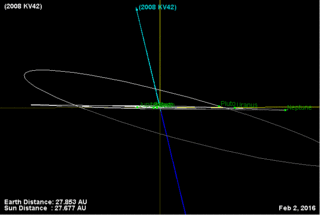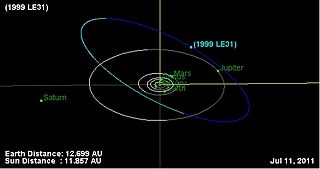Related Research Articles
Damocloids are a class of minor planets such as 5335 Damocles and 1996 PW that have Halley-type or long-period highly eccentric orbits typical of periodic comets such as Halley's Comet, but without showing a cometary coma or tail. David Jewitt defines a damocloid as an object with a Jupiter Tisserand invariant (TJ) of 2 or less, while Akimasa Nakamura defines this group with the following orbital elements:
(65407) 2002 RP120, provisional designation 2002 RP120, is a trans-Neptunian object and damocloid from the outer Solar System. Its orbit is retrograde and comet-like, and has a high eccentricity. It was discovered on 4 September 2002 by astronomers with the LONEOS survey at Anderson Mesa Station, Arizona, in the United States. The unusual object measures approximately 14.6 kilometers (9.1 miles) in diameter and is likely elongated in shape. It is a slow rotator and potentially a tumbler as well. The object was probably ejected from the ecliptic by Neptune.
20461 Dioretsa is a centaur and damocloid on a retrograde, cometary-like orbit from the outer Solar System. It was discovered on 8 June 1999, by members of the LINEAR team at the Lincoln Laboratory Experimental Test Site near Socorro, New Mexico, United States. The highly eccentric unusual object measures approximately 14 kilometers in diameter. It was named Dioretsa, the word "asteroid" spelled backwards.

(528219) 2008 KV42 (provisional designation:2008 KV42; nicknamed Drac) is a trans-Neptunian object and the first one with a retrograde orbit to be discovered. This retrograde motion with an orbital inclination of 103° suggests that it is the missing link between its source in the Hills cloud and Halley-type comets, thus providing further insight into the evolution of the outer Solar System. The object measures approximately 77 kilometers (48 miles) in diameter. With a semi-major axis of 42 AU, it takes about 269 years to complete an orbit around the Sun.
(434620) 2005 VD, provisional designation 2005 VD, is a centaur and damocloid on a retrograde orbit from the outer Solar System, known for having the second most highly inclined orbit of any small Solar System body, behind 2013 LA2. It was the most highly inclined known object between 2005 and 2013. The unusual object measures approximately 6 kilometers in diameter.

(612093) 1999 LE31, prov. designation: 1999 LE31, is a centaur and damocloid on a retrograde and eccentric orbit from the outer region of the Solar System. It was first observed on 12 June 1999, by astronomers with the LINEAR program at the Lincoln Lab's ETS near Socorro, New Mexico, in the United States. The unusual object measures approximately 17 kilometers (11 miles) in diameter.
2005 VX3 is trans-Neptunian object and retrograde damocloid on a highly eccentric, cometary-like orbit. It was first observed on 1 November 2005, by astronomers with the Mount Lemmon Survey at the Mount Lemmon Observatory in Arizona, United States. The unusual object measures approximately 7 kilometers (4 miles) in diameter. It has the 3rd largest known heliocentric semi-major axis and aphelion. Additionally its perihelion lies within the orbit of Jupiter, which means it also has the largest orbital eccentricity of any known minor planet.
2000 DG8 is a dark centaur and damocloid on a retrograde and highly eccentric orbit from the outer region of the Solar System. It was first observed on 25 February 2000, by astronomers with the LINEAR program at the Lincoln Lab's ETS near Socorro, New Mexico, United States. It has not been observed since 2001. The unusual object measures approximately 16 kilometers (9.9 miles) in diameter.
2013 LA2 is a centaur and damocloid on a cometary-like and retrograde orbit from the outer Solar System, suggesting that it is an extinct comet. It was first observed on 1 June 2013 by astronomers with the Pan-STARRS survey at Haleakala Observatory, Hawaii, in the United States. The object measures approximately 1.8 kilometers (1.1 miles) in diameter. It holds the record for having the highest orbital inclination of any known minor planet.
(471325) 2011 KT19, nicknamed Niku, is a trans-Neptunian object whose orbit is tilted 110° with respect to the planets' orbital plane. Thus, it has a nearly polar retrograde orbit around the Sun.
2014 YX49 is a centaur and Uranus co-orbital, approximately 77 kilometers (48 miles) in diameter, first observed on December 26, 2014, by the Pan-STARRS survey. It is the second known centaur on a tadpole orbit with Uranus, and the fourth Uranus co-orbital discovered after 83982 Crantor, 2011 QF99 and (472651) 2015 DB216.

(127546) 2002 XU93, provisional designation 2002 XU93, is a trans-Neptunian object and centaur on highly inclined and eccentric orbit in the outer region of the Solar System. It measures approximately 170 kilometers (110 mi) in diameter and is one of few objects with such an unusual orbit. It was discovered on 4 December 2002, by American astronomer Marc Buie at the Kitt Peak National Observatory in Arizona, United States.
2017 MB7 is a trans-Neptunian object and damocloid on a cometary-like orbit from the outer Solar System, approximately 6 kilometers (4 miles) in diameter. It was first observed on 22 June 2017 by the Pan-STARRS survey at Haleakala Observatory in Hawaii, United States. This unusual object has the largest heliocentric aphelion, semi-major axis, orbital eccentricity and orbital period of any known periodic minor planet, even larger than that of 2014 FE72; it is calculated to reach several thousand AU (Earth-Sun) distances at the farthest extent of its orbit.
(342842) 2008 YB3, provisional designation: 2008 YB3, is a sizable centaur and retrograde damocloid from the outer Solar System, approximately 67 kilometers (42 miles) in diameter. It was discovered on 18 December 2008, by astronomers with the Siding Spring Survey at the Siding Spring Observatory in Australia. The minor planet was numbered in 2012 and has since not been named.
(468861) 2013 LU28, provisional designation 2013 LU28 is a highly eccentric trans-Neptunian object, retrograde centaur and damocloid from the outer regions of the Solar System. It was discovered on 8 June 2013 by astronomers with the Mount Lemmon Survey at the Mount Lemmon Observatory in Arizona, United States. The object is unlikely a dwarf planet as it measures approximately 110 kilometers (68 miles) in diameter. It was numbered in 2016 and has not been named since.
2011 MM4, provisional designation: 2011 MM4, is a sizable centaur and retrograde damocloid from the outer Solar System, approximately 64 kilometers (40 miles) in diameter. It was discovered on 24 June 2011, by astronomers with the Pan-STARRS 1 at the Haleakala Obs. in Hawaii.
In planetary science, the term unusual minor planet, or unusual object, is used for a minor planet that possesses an unusual physical or orbital characteristic. For the Minor Planet Center (MPC), which operates under the auspices of the International Astronomical Union, any non-classical main-belt asteroid, which account for the vast majority of all minor planets, is an unusual minor planet. These include the near-Earth objects and Trojans as well as the distant minor planets such as centaurs and trans-Neptunian objects. In a narrower sense, the term is used for a group of bodies – including main-belt asteroids, Mars-crossers, centaurs and otherwise non-classifiable minor planets – that show a high orbital eccentricity, typically above 0.5 and/or a perihelion of less than 6 AU. Similarly, an unusual asteroid (UA) is an inner Solar System object with a high eccentricity and/or inclination but with a perihelion larger than 1.3 AU, which does exclude the near-Earth objects.
2006 BZ8 is a dark centaur and damocloid on a retrograde and highly eccentric orbit from the outer region of the Solar System. It was first observed on 23 January 2006 by the Catalina Sky Survey at the Catalina Station near Tucson, Arizona, United States. It has not been observed since 2008. This unusual object is estimated around 9–23.5 kilometers (5.6–15 miles) in diameter.
2006 RJ2 is a centaur and damocloid on a retrograde and highly eccentric orbit from the outer region of the Solar System. It was first observed on 14 September 2006 by the Catalina Sky Survey at the Catalina Station near Tucson, Arizona, United States. It has not been observed since 2006. This unusual object measures approximately 3 kilometers (1.9 miles) in diameter.
References
- 1 2 3 4 5 "2017 SV13". Minor Planet Center. International Astronomical Union. Retrieved 8 August 2021.
- 1 2 3 "JPL Small-Body Database Browser: (2017 SV13)" (2017-10-28 last obs.). Jet Propulsion Laboratory . Retrieved 8 August 2021.
- 1 2 3 4 Johnston, Wm. Robert (18 August 2020). "List of Known Trans-Neptunian Objects". Johnston's Archive. Retrieved 8 August 2021.
- ↑ "List Of Other Unusual Objects". Minor Planet Center. International Astronomical Union. 8 August 2021. Retrieved 8 August 2021.